Arthur Fadden
| The Right Honourable Sir Arthur Fadden GCMG | |
|---|---|
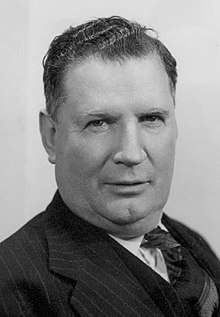 | |
| 13th Prime Minister of Australia | |
|
In office 29 August 1941 – 7 October 1941 | |
| Monarch | George VI |
| Governor-General | Lord Gowrie |
| Preceded by | Robert Menzies |
| Succeeded by | John Curtin |
| Leader of the Opposition | |
|
In office 7 October 1941 – 23 September 1943 | |
| Prime Minister | John Curtin |
| Preceded by | John Curtin |
| Succeeded by | Robert Menzies |
| Treasurer of Australia | |
|
In office 28 October 1940 – 6 October 1941 | |
| Prime Minister |
Robert Menzies Arthur Fadden |
| Preceded by | Percy Spender |
| Succeeded by | Ben Chifley |
|
In office 19 December 1949 – 9 December 1958 | |
| Prime Minister | Robert Menzies |
| Preceded by | Ben Chifley |
| Succeeded by | Harold Holt |
| Leader of the Country Party Elections: 1943, 1946, 1949, 1951, 1954, 1955 | |
|
In office 12 March 1941 – 26 March 1958 | |
| Deputy | John McEwen |
| Preceded by | Archie Cameron |
| Succeeded by | John McEwen |
| Deputy Leader of the Country Party | |
|
In office 16 October 1940 – 12 March 1941 Acting leader: 16 October 1940 – 12 March 1941 | |
| Leader | Vacant |
| Preceded by | Harold Thorby |
| Succeeded by | John McEwen |
| Member of the Australian Parliament for Darling Downs | |
|
In office 6 November 1936 – 10 December 1949 | |
| Preceded by | Littleton Groom |
| Succeeded by | Reginald Swartz |
| Member of the Australian Parliament for McPherson | |
|
In office 10 December 1949 – 14 October 1958 | |
| Preceded by | New seat |
| Succeeded by | Charles Barnes |
| Member of the Queensland Legislative Assembly for Kennedy | |
|
In office 11 June 1932 – 11 May 1935 | |
| Preceded by | Harry Bruce |
| Succeeded by | Cecil Jesson |
| Personal details | |
| Born |
13 April 1894 Ingham, Queensland, Australia |
| Died |
21 April 1973 (aged 79) Brisbane, Queensland, Australia |
| Resting place | Mount Thompson Crematorium |
| Political party |
CPNP (until 1936) Country Party (after 1936) |
| Spouse(s) |
Ilma Thornber (m. 1916) |
| Children | 4 |
| Education | Walkerston State School |
| Occupation | Accountant |
Sir Arthur William Fadden, GCMG, PC (13 April 1894 – 21 April 1973) was an Australian politician who served as Prime Minister of Australia from 29 August to 7 October 1941. He was the leader of the Country Party from 1940 to 1958.
Fadden was born in Ingham, Queensland, to Irish immigrant parents. He was raised in Walkerston, and left school at the age of 15. He was appointed town clerk of Mackay in 1916, but following the 1918 cyclone moved to Townsville and opened an accountancy firm. He was elected to the Townsville City Council in 1930, and in 1932 was elected to the Queensland Legislative Assembly for the Country and Progressive National Party. Fadden lost his seat in 1935, but the following year won a by-election to the federal Division of Darling Downs.
In March 1940, Fadden was named a minister without portfolio in the government of Robert Menzies, who led the United Australia Party in a coalition with the Country Party. A few months later, following the deaths of three senior ministers in an air crash, he took over as Minister for Air and Minister for Civil Aviation. In October 1940, Fadden replaced Harold Thorby as deputy leader of the Country Party. The leadership was vacant at the time, following Archie Cameron's resignation, so Fadden became acting leader of the party and de facto deputy prime minister. Menzies subsequently promoted him to Treasurer of Australia.
Fadden served as acting prime minister for four months early in 1941 (while Menzies was away in Europe), and became popular for his conciliatory manner. He became the official leader of the Country Party following a ballot in March 1941. In August 1941, Menzies resigned as prime minister after losing the confidence of his ministry. Fadden was elected leader of the UAP–Country coalition in his place, and consequently became prime minister. However, he held office for just 39 days before being replaced by John Curtin, whose Labor Party had successfully moved a motion of no confidence. After losing the prime ministership, Fadden continued on as Leader of the Opposition for two more years. He eventually resigned in favour of Menzies following the coalition's massive defeat at the 1943 election.
When Menzies returned as prime minister in 1949, Fadden became Treasurer for a second time, holding office until his retirement from politics in 1958. Only Peter Costello has served in the position for longer. Fadden enjoyed one of the most rapid rises in Australian political history, moving from private citizen to the prime ministership in just 11 years. He was the first prime minister born in Queensland, and the first and only member of the Country Party to become prime minister with his own mandate (rather than just serving as a caretaker after the death of a predecessor).
Early life
Fadden was born in Ingham, Queensland, on 13 April 1894. He was the eldest of ten children – seven sons and three daughters – born to Annie (née Moorhead) and Richard John Fadden. His parents were both born in Ireland, his mother in County Tyrone and his father in County Galway. Fadden moved to Walkerston at a young age, where his father was officer-in-charge of the local police station.[1] He had a "typical country childhood", but suffered the deaths of three of his younger siblings in separate accidents. Fadden received his only formal education at the Walkerston State School, except for a brief period at Te Kowai while his usual school was being renovated. His first jobs included collecting cane beetles and performing sound effects at the local cinema. Fadden left school at the age of 15 and began working as a "billy boy" (odd-job man) on a cane-cutting gang at Pleystowe.[2] He later secured an indoor job as an office boy at the Pleystowe Sugar Mill, where his colleagues include two future Labor MPs – Maurice Hynes and George Martens.[3] In his spare time, he developed an interest in the theatre, both as a performer and treasurer of the local company.[4]
In April 1913, Fadden moved to Mackay to become assistant town clerk of the Mackay Town Council. He defeated 56 other applicants for the position.[4] In 1916, his superior, Frederick Morley, was dismissed as town clerk over allegations of theft, which Fadden himself had uncovered. Morley eventually received a two-year jail term, and Fadden was promoted in his place, again defeating more than 50 other applicants; he was reputedly the "youngest town clerk in Australia". He had attempted to enlist in the Australian Army the previous year, but was rejected on health grounds. In 1918, Fadden served on the committee of the relief fund for the Mackay cyclone, which devastated the town and killed thirty people.[5] However, he resigned as town clerk in September of that year and moved to Townsville (the largest settlement in North Queensland), where he established his own accountancy firm.[6] He had qualified as an accountant through a correspondence course from a school in Melbourne.[4]
According to his memoirs, Fadden initially struggled to make ends meet as an accountant, and considered relocating to Brisbane. However, he eventually found an unused loophole in the tax code that allowed him to gain a competitive advantage. His business prospered thereafter, and he was able to take on partners and opened a second office in Brisbane.[6] In 1930, Fadden was elected to the Townsville City Council as part of a non-partisan grouping calling themselves the "serviceable six". He developed a feud with the city's chief engineer, Sidney Roberts, whom he publicly criticised for using coal from New South Wales instead of from the local Bowen Basin mines. He was once again able to use his auditing skills to his advantage, getting Roberts fired for inconsistencies in his balance sheets. The resulting publicity served as a springboard for his political career.[7]
State politics
At the 1932 state election, Fadden was elected to the Queensland Legislative Assembly as a member of the Country and Progressive National Party (CPNP). Aided by a favourable redistribution, he won the seat of Kennedy from the Labor Party by just 62 votes. He was the only candidate from his party to win a seat from Labor, which won majority government on a swing of almost 10 points.[8] In parliament, Fadden came to notice as a critic of the new government's financial operations. He accused the government of lacking transparency and accountability, particularly in its use of trust funds which he said had been used to cover up revenue deficiencies. His speeches impressed both his party and political correspondents, and he was asked to write a series of articles for The Courier-Mail.[9]
Fadden was the CPNP's lead speaker in the 1934 budget debates, effectively making him the chief financial spokesman for the opposition.[10] In the lead-up to the 1935 state election, a redistribution turned Kennedy into a safe Labor seat. It was alleged by the opposition that the government had specifically targeted Fadden's seat in order to remove him as a political threat. Faced with certain defeat, he chose to run in the neighbouring seat of Mirani. However, he lost to Labor's Ted Walsh by 224 votes, as the government won a landslide victory. In his memoirs, he accused Labor of having pork-barreled Mirani in the lead-up to the election to ensure his defeat.[11]
Move to federal politics
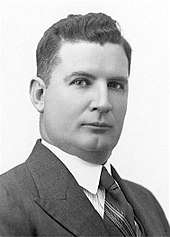
After losing his seat in state parliament, Fadden initially returned to his accounting practice.[12] In early 1936, he joined the Queensland Country Party, which had split from the CPNP in order to align with the federal Country Party.[13] Later that year, he was elected to the House of Representatives at a by-election for the Division of Darling Downs. It was caused by the death of the previous member, Littleton Groom, who was a member of the United Australia Party (UAP). Fadden, who had no previous connection with the area, was the first member of his party to contest the seat; the UAP suffered a negative swing of over 40 points.[14] He consolidated his hold on the seat at the 1937 federal election, held less than a year later.[15]
Menzies Government (1939–41)
In April 1939, Prime Minister Joseph Lyons died in office and was replaced by Country Party leader Earle Page on an interim basis. When Robert Menzies was elected by the United Australia Party (UAP) as Lyons' replacement, Page gave a speech accusing Menzies of disloyalty and questioning his record of military service. As a result of Page's attacks, which they deemed unfair, Fadden and Bernard Corser resigned from the parliamentary Country Party to sit as "Independent Country" members; they were soon followed by Oliver Badman and Thomas Collins.[16] Fadden was generally seen as the leader of the group. When Page was forced out of the leadership in September, they attempted to rejoin the party, but the remaining members opted – by a single vote – not to re-admit them. Archie Cameron, generally seen as Page's ally, was elected as the party's new leader. Fadden did not regard Cameron favourably, in one debate stating: "I take this opportunity to declare without the slightest degree of reservation that the honourable gentleman is not my leader".[17] When asked in another debate if he were still a member of the Country Party, he replied "no, I am not, thank goodness, as it is now constituted and under its present leadership". In early November, however, Cameron invited the four breakaways to rejoin the party in the interests of unity, which they accepted.[18]
The Country Party's coalition with the UAP had lapsed following Menzies' elevation to the prime ministership. In March 1940, Menzies and Cameron agreed to resume the coalition, providing an opportunity for five Country Party members to be added to the ministry. Cameron somewhat unexpectedly nominated Fadden as a Country Party representative, and he was appointed as an assistant minister to the Treasurer (Percy Spender) and the Minister for Supply and Development (Frederick Stewart).[19] In August 1940, Fadden narrowly escaped being killed in the Canberra air disaster, which claimed the lives of three government ministers and the Chief of the General Staff. He was scheduled to be aboard the flight, which was transporting the ministers back to Canberra after a cabinet meeting in Melbourne, but instead took an overnight train. He traded places with Richard Elford (James Fairbairn's private secretary), who had wanted to stay in Melbourne to celebrate a wedding anniversary; both Elford and Fairbairn were among those killed. After the crash, Fadden replaced Fairbairn as Minister for Air and Minister for Civil Aviation; he also continued as assistant minister to the Treasurer.[20]
The September 1940 federal election resulted in a hung parliament. The UAP–Country coalition was able to remain in power with the support of two independent MPs, Alexander Wilson and Arthur Coles. The Country Party lost three seats to the Labor Party, and on 16 October the parliamentary party voted to remove Archie Cameron as leader. John McEwen and Earle Page both nominated for the leadership, and Fadden intended to nominate for the deputy leadership. McEwen and Page were tied at eight votes each after three separate ballots. During a break for dinner, Fadden was asked to become interim leader as a compromise between the two candidates, with the intention that another leadership election would be held in a few months. He was then elected unopposed as deputy leader and thus acting leader of the party. According to his biographer Tracey Arklay, "Fadden was selected because the majority in the party room considered that he was the man most likely to be able to broker deals and negotiate with Menzies and the UAP".[21] Edgar Holt believed Fadden's personality was a major factor – "he had no obvious ambitions and he suffered from no delusions of grandeur [...] he was amiable and gregarious" – but also thought that Page had allowed Fadden to assume the leadership in order to deny it to McEwen.[22]
As the acting leader of his party, Fadden became the de facto deputy prime minister and joined the Advisory War Council. He was sworn in as Treasurer on 28 October 1940, succeeding Percy Spender, and presented his first budget less than a month later on 21 November.[23] The budget featured increased levels of spending due to the ongoing war, offset by significant increases in taxation – including a reduction in the tax-free threshold, increased company taxes, and a tax on undistributed profits. In presenting the budget, Fadden noted that it brought about "the heaviest financial imposts ever placed upon the people of Australia".[24] It was highly unpopular among the general public, which up until that point had perceived the war to be still quite distant. The independent MPs contemplated voting with the opposition to reject the budget, but after negotiations and some amendments it was able to be passed, allowing the government to continue in power.[25]
Prime Minister of Australia
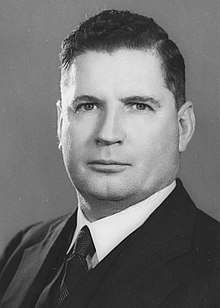
In August 1941 Robert Menzies resigned as Prime Minister.[26] Although the non-Labor Coalition had been in power for a decade, the UAP was so bereft of leadership that on 28 August a joint UAP-Country meeting chose Fadden as Coalition leader even though the Country Party was the smaller of the two non-Labor parties. Fadden was duly sworn in as Prime Minister the next day, and also remained Treasurer. He was the only member of the Country/National Party to serve as Prime Minister without an expectation of a short tenure (the other two Country/National Prime Ministers, Page and McEwen, served as caretakers).
Nevertheless, Fadden's term of office was troubled from the start. Even parliamentarians in his own party feared the worst. It was later reported that Fadden decided against moving into The Lodge, the official Prime Minister's residence in Canberra, after fellow Country Party member Archie Cameron crudely told him that he would "scarcely have enough time to wear a track from the backdoor to the shithouse before you’ll be out".[27]
On 3 October, the two independent legislators who had been keeping the Coalition in office for the last year, Arthur Coles and Alexander Wilson, voted against Fadden's budget. Coles and Wilson had been so disgusted with how Menzies had been treated that they refused to support the Coalition any longer. Due to this loss of supply, Fadden submitted his government's resignation to the Governor-General Lord Gowrie later the same day. This was the last occasion to date on which an Australian government was forced to resign after being defeated on the floor of the House of Representatives.[28] Fadden joked that he was like the Flood: he had "reigned for 40 days and 40 nights".
The Governor-General was reluctant to call an election for a House that was barely a year old, especially considering that the war had recently been brought to the nation's doorstep with Japan's advances. However, he would have been left with no other option if Labor leader John Curtin did not have enough support to govern. With this in mind, Gowrie summoned Coles and Wilson and obtained their assurances that they would support Curtin as Prime Minister and end the instability that had plagued the government since 1940. Coles and Wilson agreed to this, and Curtin was sworn in on 7 October.
Leader of the Opposition
Following the fall of his ministry, a joint UAP-Country Party meeting endorsed Fadden as Leader of the Opposition, even though the UAP was nominally the senior coalition partner. As a result Menzies resigned the leadership of the UAP, which was so bereft it was forced to elect former Prime Minister Billy Hughes as its new leader. The Coalition sank into near-paralysis in opposition. Even allowing for Curtin's personal popularity, as well as the significant advantages which an incumbent government in a Westminster system has in wartime, Fadden proved a disappointment as Leader of the Opposition; he was unable to get the better of Curtin. The Coalition suffered a crushing loss in the 1943 election. It was reduced to 19 seats, including a mere seven for Fadden's Country Party. Accepting responsibility for this severe defeat, Fadden then handed the Opposition leadership back to Menzies, who had resumed the UAP leadership.
Later years
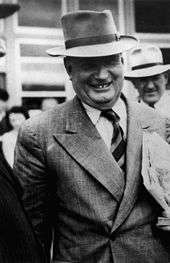
After the Coalition was again vanquished at the 1946 election, Fadden resumed his political partnership with Menzies. Two years earlier, Menzies had folded the UAP into the new Liberal Party of Australia. There was some speculation that the Country Party would be included in the merger (as had already happened in several states), but Fadden was keen to assert the independence of his party.
Always an outspoken conservative, in the late 1940s he became a strong anti-communist, urging Menzies to ban the Communist Party if he ever came to power. Indeed, in the lead up to the 1949 election, Fadden often made inflammatory claims about the "socialist" nature of the Labor Party which Menzies could then "clarify" or repudiate as he saw fit, thus appearing more "moderate". His often extreme views were concealed behind a jolly and jovial public manner and he enjoyed his nickname of "Artie."
Fadden was a friend of Robert Frederick Bird Wake, one of the country's leading security experts at the time. It was an odd relationship, based on their mutual love of Queensland and Queenslanders. Wake, who was a founder director with the Australian Security Intelligence Organisation (1949), was supplied with inside information by Fadden about security leaks in the UK. Although Wake was more inclined to support the Labor Party, the relationship stood the test of time and proved mutually beneficial.[29]
The Coalition won a massive victory in the 1949 election, and Fadden, who transferred to the newly created seat of McPherson on the Gold Coast, became Treasurer in the second Menzies government. Although inflation was high in the early 1950s, forcing him to impose several "horror budgets", he generally presided over a booming economy, with times especially good for farmers.
Fadden retired at the 1958 election. He became the Chairman of Centenary Estate which was half owned by LJ Hooker.[30] Centenary Estate developed the Centenary Suburbs, which was a housing development undertaken in the 1960s, south west of Brisbane. Thereafter he faded from public view, living quietly in Brisbane until his death in 1973. He was accorded a state funeral which proceeded from the Toowong Presbyterian Church to the Mt Thompson Crematorium.[31][32]
Personal life
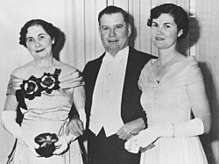
On 27 December 1916, Fadden married Ilma Nita Thornber (1895–1987).[33] She was the daughter and sister-in-law of two Mayors of Mackay – James Thornber and George Fay.[34][35] The couple had four children together – Gordon, John, Mavis, and Betty.[36]
Honours
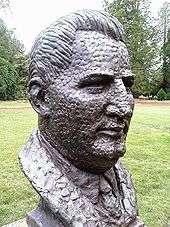
Fadden was made a Knight Commander of the Order of St Michael and St George (KCMG) in 1951.[37] The honour was conferred upon Fadden by King George VI in London on 31 January 1952, only a week before the King's death.[38] In 1958 Fadden raised to Knight Grand Cross (GCMG) of the order.[39] The Canberra suburb of Fadden and the Division of Fadden are named after him.
In 1975 he was honoured on a postage stamp bearing his portrait issued by Australia Post.[40][41]
See also
References
- ↑ Arklay, Tracey M. (2014). Arthur Fadden: A Political Silhouette. Australian Scholarly Publishing. p. 1.
- ↑ Arklay (2014), p. 2.
- ↑ Arklay (2014), p. 3.
- 1 2 3 Arklay (2014), p. 4.
- ↑ Arklay (2014), p. 5.
- 1 2 Arklay (2014), p. 6.
- ↑ Arklay (2014), p. 7.
- ↑ Arklay, Tracey M. (2010). Arthur Fadden: A Political Silhouette (PDF) (PhD thesis). Griffith University. p. 58.
- ↑ Arklay (2010), pp. 61–64.
- ↑ Arklay (2010), p. 67.
- ↑ Arklay (2010), p. 68.
- ↑ Arklay (2010), p. 70.
- ↑ Cribb (1988)
- ↑ Arklay (2010), pp. 71–76.
- ↑ Arklay (2010), p. 81.
- ↑ Arklay (2010), p. 87.
- ↑ Arklay (2010), p. 95.
- ↑ Arklay (2010), p. 89.
- ↑ Arklay (2010), p. 102.
- ↑ Arklay (2010), p. 103.
- ↑ Arklay (2010), p. 105.
- ↑ Arklay (2010), p. 107.
- ↑ Arklay (2010), p. 107.
- ↑ Arklay (2010), p. 110.
- ↑ Arklay (2010), p. 111.
- ↑ "Archived copy". Archived from the original on 13 November 2013. Retrieved 2012-10-17.
- ↑ Arklay, p. 80.
- ↑ Gavin Souter, Acts of Parliament, p. 341
- ↑ Valdemar Robert Wake, No Ribbons or Medals: the story of 'Hereward' an Australian counter espionage officer
- ↑ “£8 Million Town To Be Built”, The Sydney Morning Herald, 11 November 1961. Retrieved 26 November 2017.
- ↑ "Family Notices". The Canberra Times. 47, (13, 418). Australian Capital Territory, Australia. 25 April 1973. p. 13. Retrieved 8 May 2016 – via National Library of Australia.
- ↑ Arthur William Fadden (1895 - 1973) — Heaven Address. Retrieved 8 May 2016.
- ↑ Australia's PMs > Arthur Fadden > Ilma Fadden - National Archives of Australia. Retrieved 22 March 2018.
- ↑ James Henry Thornber - Mayors of Mackay. Retrieved 22 March 2018.
- ↑ George Bergin Fay - Mayors of Mackay. Retrieved 22 March 2018.
- ↑ Fast facts: Arthur Fadden - National Archives of Australia. Retrieved 22 March 2018.
- ↑ It's an Honour - Fadden KCMG Archived 2 October 2008 at the Wayback Machine.
- ↑ "Sir Arthur Fadden Invested By King". Nla.gov.au. 1 February 1952. Retrieved 30 March 2011.
- ↑ It's an Honour - Fadden GCMG Archived 2 October 2008 at the Wayback Machine.
- ↑ "Arthur Fadden". Australian Coin and Stamp Company. Retrieved 22 November 2012.
- ↑ "Australian Stamps - Year 1975". Australia Postage Stamps. Archived from the original on 19 November 2012. Retrieved 22 November 2012.
Further reading
- Arklay, T. (2014) Political Silhouette, Australian Scholarly: Melbourne. ISBN 978 1 925003 84 0.
- Fadden, Arthur (1969), They Called Me Artie, Jacaranda Press
- Hughes, Colin A (1976), Mr Prime Minister. Australian Prime Ministers 1901-1972, Oxford University Press, Melbourne, Victoria, Ch.14. ISBN 0-19-550471-2
External links
| Wikimedia Commons has media related to Arthur Fadden. |
- "Arthur Fadden". Australia's Prime Ministers. National Archives of Australia. Archived from the original on 26 July 2010. Retrieved 29 June 2010.
- Cribb, Margaret Bridson (1988). "Fadden, Sir Arthur William (1894 - 1973)". Australian Dictionary of Biography. Canberra: Australian National University. Retrieved 29 June 2010.
- "Prime Ministers of Australia: Arthur Fadden". National Museum of Australia. Retrieved 29 June 2010.
| Political offices | ||
|---|---|---|
| Preceded by James Fairbairn |
Minister for the Air Minister for Civil Aviation 1940 |
Succeeded by John McEwen |
| Preceded by Robert Menzies |
Treasurer of Australia 1940 – 1941 |
Succeeded by Ben Chifley |
| Prime Minister of Australia 1941 |
Succeeded by John Curtin | |
| Preceded by John Curtin |
Leader of the Opposition 1941 – 1943 |
Succeeded by Robert Menzies |
| Preceded by Ben Chifley |
Treasurer of Australia 1949 – 1958 |
Succeeded by Harold Holt |
| Parliament of Australia | ||
| Preceded by Littleton Groom |
Member for Darling Downs 1936–1949 |
Succeeded by Reginald Swartz |
| New division | Member for McPherson 1949–1958 |
Succeeded by Charles Barnes |
| Parliament of Queensland | ||
| Preceded by Harry Bruce |
Member for Kennedy 1932 - 1935 |
Succeeded by Cecil Jesson |
| Party political offices | ||
| Preceded by Harold Thorby |
Deputy Leader of the Country Party 1940 – 1941 |
Succeeded by John McEwen |
| Preceded by Archie Cameron |
Leader of the Country Party 1941 – 1958 |
Succeeded by John McEwen |
